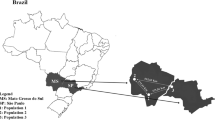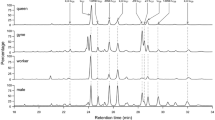Abstract
We characterized the variation in cuticular hydrocarbon mixtures between seven colonies of the Formosan subterranean termite,Coptotermes formosanus Shiraki, from the same population. We report differences between castes, between colonies, and within the population over time to assess seasonality. Colonies ofC. formosanus from Oahu, Hawaii, were sampled for 25 months. Each month, one sample each of 200 workers, 50 soldiers, nymphs, or alates from each colony was subjected to gas chromatography-mass spectrometry (GC-MS) analysis of the cuticular hydrocarbons. We resolved 39 individual peaks and identified 52 individual or isomeric mixtures of hydrocarbons. Onlyn-alkanes and methyl-branched alkanes occur; no olefins were found. Internally branched monomethylalkanes were the most abundant class of hydrocarbons, representing 45% to 50% of the total 9-;11-;13-Methyl-heptacosane accounted for over 30% of the total hydrocarbon for all castes. 2-Methyl- and 3-methylalkanes comprise approximately 30% of the total. Internally branched dimethylalkanes constitute 15% to 20% of the total cuticular hydrocarbon. Only one trimethylalkane, 13,15,17-trimethylnonacosane, was found in small amounts. The hydrocarbon mixtures of all four castes were similar. Quantitative differences in hydrocarbon mixtures among the castes were easily displayed using canonical discriminant analysis. Soldiers and workers are significantly different from one another and from nymphs and alates. Nineteen peaks are statistically significant between workers and soldiers. Nymphs and alates were not statistically different. We detected statistically significant quantitative differences between colonies in 18 peaks for workers and 12 peaks for soldiers. Each of the colonies ofC. formosanus can be separated from the others by the proportions of their hydrocarbon components. We detected statistically significant differences between months of the year for 12 peaks for workers and four peaks for soldiers; two peaks each for workers and soldiers showed distinct, seasonal trends. This seasonal shift in proportions of hydrocarbons correlates with the production of alates.
Similar content being viewed by others
References
Atkinson, T. H., Rust, M. K., andSmith, J. L. 1993. The Formosan subterranean termite,Coptotermes formosanus Shiraki (Isoptera: Rhinotermitidae), established in California.PanPacific Entomol. 69:111–113.
Beal, R. H. 1987. Introductions ofCoptotermes formosanus Shiraki to the continental United States, pp. 48–53,in M. Tamashiro and N-Y. Su (eds.). Biology and Control of the Formosan Subterranean Termite. Res. Ext. Series 083, Univ. of Hawaii, Honolulu.
Bess, H. A. 1970. Termites of Hawaii and the oceanic islands, pp. 449–476,in F. M. Weesner and K. Krisna (eds.). Biology of Termites, Volume II. Academic Press, New York.
Blomquist, G. J., Howard, R. H., andMcDaniel, C. A. 1979. Structure of the cuticular hydrocarbons of the termiteZootermopsis angusticollis (Hagen).Insect Biochem. 9:371–374.
Blomquist, G. J., Nelson, D. R., andde Renobales, M. 1987. Chemistry, biochemistry, and physiology of insect cuticular lipids.Arch. Insect Biochem. Physiol. 6:227–265.
Broughton, R. E., andGrace, J. K. 1994. Lack of mitochondrial DNA variation in an introduced population of the Formosan subterranean termite (Isoptera: Rhinotermitidae).Sociobiology 24:121–126.
Brown, W. V., Watson, J. A. L., Carter, F. L., Lacey, M. J., Barrett, R. A., andMcDaniel, C. A. 1990. Preliminary examination of cuticular hydrocarbons of worker termites as chemotaxonomic characters for some Australian species ofCoptotermes (Isoptera: Rhinotermitidae).Sociobiology 16:305–328.
Brown, W. V., Watson, J. A. L., andLacey, M. J. 1994. The cuticular hydrocarbons of workers of three AustralianCoptotermes species,C. michaelseni, C. brunneus andC. dreghorni (Isoptera: Rhinotermitidae).Sociobiology 23:277–291.
Brown, W. V., Watson, J. A. L., Lacey, M. J., Morton, R., andMiller, L. R. 1996. Composition of cuticular hydrocarbons in the Australian harvester termiteDrepanotermes perniger (Isoptera: Termidae): Variation among individuals, castes, colonies, and locations.Sociobiology 27:181–197.
Chambers, D. M., Zungoli, P. A., andHill, H. S., Jr. 1988. Distribution and habitats of the Formosan subterranean termite (Isoptera: Rhinotermitidae) in South Carolina.J. Econ. Entomol. 81:1611–1619.
Haverty, M. I., andHoward, R. H. 1981. Production of soldiers and maintenance of soldier proportions by laboratory experimental groups ofReticulitermes flavipes (Kollar) andReticulitermes virginicus (Banks) (Isoptera: Rhinotermitidae).Insects Sociaux 28:32–39.
Haverty, M. I., Page, M., Nelson, L. J., andBlomquist, G. J. 1988. Cuticular hydrocarbons of dampwood termites,Zootermopsis: intra- and intercolony variation and potential as taxonomic characters.J. Chem. Ecol. 14:1035–1058.
Haverty, M. I., Nelson, L. J., andPage, M. 1990a. Cuticular hydrocarbons of four populations ofCoptotermes formosanus Shiraki in the United States: Similarities and origins of introductions.J. Chem. Ecol. 16:1635–1647.
Haverty, M. I., Thorne, B. L., andPage, M. 1990b. Surface hydrocarbon components of two species ofNasutitermes from Trinidad.J. Chem. Ecol. 16:2441–2450.
Haverty, M. I., Nelson, L. J., andPage, M. 1991. Preliminary investigations of the cuticular hydrocarbons from North AmericanReticulitermes and tropical and subtropicalCoptotermes (Isoptera: Rhinotermitidae) for chemosystematic studies.Sociobiology 19:51–76.
Haverty, M. I., Nelson, L. J., Thorne, B. L., Collins, M. S., Darlington, J. P. E. C., andPage, M. 1992. Cuticular hydrocarbons for species determination of tropical termites, pp. 58–66,in C. E. Conrad and L. A. Newell (tech. coords.) Proceedings of the session on Tropical Forestry for People of the Pacific. Pacific Science Congress, Honolulu, Hawaii, May 22–28, 1991. USDA Forest Service Gen. Tech. Report PSW-129.
Haverty, M. I., Thorne, B. L., andNelson, L. J. 1996. Hydrocarbons ofNasutitermes acajutlae and a comparison of methodologies for sampling cuticular hydrocarbons of caribbean termites for taxonomic and ecological studies.J. Chem. Ecol. 22(11):(In press).
Howard, R. W., andHaverty, M. I. 1981. Seasonal variation in caste proportions of field colonies ofReticulitermes flavipes (Kollar).Environ. Entomol. 10:546–549.
Howard, R. W., McDaniel, C. A., andBlomquist, G. J. 1978. Cuticular hydrocarbons of the eastern subterranean termite,Reticulitermes flavipes (Kollar) (Isoptera: Rhinotermitidae).J. Chem. Ecol. 4:233–245.
Howard, R. W., McDaniel, C. A., Nelson, D. R., Blomquist, G. J., Gelbaum, L. T., andZalkow, L. H. 1982. Cuticular hydrocarbons ofReticulitermes virginicus (Banks) and their role as potential species- and caste-recognition cues.J. Chem. Ecol. 8:1227–1239.
Howard, R. W., Thorne, B. L., Levings, S. C., andMcDaniel, C. A. 1988. Cuticular hydrocarbons as chemotaxonomic characters forNasutitermes corniger (Motschulsky) andN. ephratae (Holmgren) (Isoptera: Termitidae).Ann. Entomol. Soc. Am. 81:395–399.
Jackson, L. L., andBlomquist, G. J. 1976. Insect waxes, pp. 201–233,in P. E. Kolattukudy (ed.). Chemistry and Biochemistry of Natural Waxes. Elsevier, Amsterdam.
Kistner, D. H. 1985. A new genus and species of termiophilous Aleocharinae from mainland China associated withCoptotermes formosanus and its zoogeographical significance (Coleoptera: Staphylinidae).Sociobiology 10:93–104.
Korman, A. K., andPashley, D. P. 1991. Genetic comparisons among U.S. populations of Formosan subterranean termites.Sociobiology 19:41–50.
La Fage, J. P. 1987. Practical considerations of the Formosan subterranean termite in Louisiana: A 30-year-old problem, pp. 37–42,in M. Tamashiro and N-Y. Su (eds). Biology and Control of the Formosan Subterranean Termite. Res. Ext. Series 083, Univ. of Hawaii, Honolulu.
Lockey, K. H. 1988. Review. Lipids of the insect cuticle: origin, composition, and function.Comp. Biochem. Physiol. 89B:595–645.
McDaniel, C. A. 1990. Cuticular hydrocarbons of the Formosan termiteCoptotermes formosanus.Sociobiology 16:265–273.
Nelson, D. R., andSukkestad, D. R. 1970. Normal and branched aliphatic hydrocarbons from eggs of the tobacco hornworm.J. Lipid Res. 13:413–421.
Nelson, D. R., Fatland, C. L., Howard, R. W., McDaniel, C. A., andBlomquist, G. J. 1980. Re-analysis of the cuticular methylalkanes ofSolenopsis invicta andS. richteri.Insect Biochem. 10:409–418.
Nevo, E. 1978. Genetic variation in natural populations: patterns and theory.Theoret. Popul. Biol. 13:121–177.
Nutting, W. L. 1969. Flight and colony foundation, pp. 233–282,in F. M. Weesner and K. Krisna (eds.). Biology of Termites, Volume I. Academic Press, New York.
Page, M., Nelson, L. J., Haverty, M. I., andBlomquist, G. J. 1990a. Cuticular hydrocarbons of eight species of North American cone beetles,Conophthorus Hopkins.J. Chem. Ecol. 16:1173–1198.
Page, M., Nelson, L. J., Haverty, M. I., andBlomquist, G. J. 1990b. Cuticular hydrocarbons as chemotaxonomic characters for bark beetles:Dendroctonus ponderosae, D. jeffreyi, D. brevicomis, andD. frontalis (Coleoptera: Scolytidae).Ann. Entomol. Soc. Amer. 83:892–901.
Pomonis, J. G., Nelson, D. R., andFatland, C. L. 1980. Insect hydrocarbons. 2. Mass spectra of dimethylalkanes and the effect of the number of methylene units between groups on fragmentation.J. Chem. Ecol. 6:965–972.
SAS. 1990. SAS/STAT User's Guide, Version 6, Fourth Edition, Vol. 1. SAS Institute, Cary, North Carolina.
Sponsler, R. C., Jordan, K. S., andAppel, A. G. 1988. New distribution record of the Formosan subterranean termite,Coptotermes formosanus Shiraki (Isoptera: Rhinotermitidae), in Auburn, Alabama.Entomol. News 99:87–89.
Strong, K. L., andGrace, J. K. 1993. Low allozyme variation in Formosan subterranean termite (Isoptera: Rhinotermitidae) colonies in Hawaii.Pan-Pacific Entomol. 69:51–56.
Su, N-Y. 1994. A case of mistaken identity. All the evidence pointed to the Formosan subterranean termite, but closer inspection proved it wasn't so.Pest Control 62:79–80.
Su, N-Y., andHaverty, M. I. 1991. Agonistic behavior among colonies of the Formosan subterranean termite,Coptotermes formosanus Shiraki (Isoptera: Rhinotermitidae), from Florida and Hawaii: Lack of correlation with cuticular hydrocarbon composition.J. Insect Behavior 4:115–128.
Su, N-Y., andScheffrahn, R. H. 1990. Economically important termites in the United States and their control.Sociobiology 17:77–94.
Su, N-Y., andScheffrahn, R. H. 1996.Coptotermes vastator Light (Isoptera: Rhinotermitidae) in Guam.Proc. Hawaiian Entomol. Soc. (In press).
Su, N-Y., andTamashiro, M. 1987. An overview of the Formosan subterranean termite (Isoptera: Rhinotermitidae) in the world, pp. 3–15,in M. Tamashiro and N-Y. Su (eds.). Biology and Control of the Formosan Subterranean Termite. Res. Ext. Series 083. Univ. of Hawaii, Honolulu.
Swezey, O. H. 1914. Notes and exhibitions.Proc. Hawaiian Entomol. Soc. 3:27.
Tamashiro, M., Fujii, J. K., andLai, P-Y. 1973. A simple method to observe, trap, and prepare large numbers of subterranean termites for laboratory and field experiments.Environ. Entomol. 2:721–722.
Tamashiro, M., Yates, J. R., andEbesu, R. H. 1987. The Formosan subterranean termite in Hawaii: Problems and control, pp. 15–22,in M. Tamashiro and N-Y. Su (eds). Biology and Control of the Formosan Subterranean Termite, Res. Ext. Series 083, Univ. of Hawaii, Honolulu.
Author information
Authors and Affiliations
Rights and permissions
About this article
Cite this article
Haverty, M.I., Grace, J.K., Nelson, L.J. et al. Intercaste, intercolony, and temporal variation in cuticular hydrocarbons ofCopotermes formosanus shiraki (Isoptera: Rhinotermitidae). J Chem Ecol 22, 1813–1834 (1996). https://doi.org/10.1007/BF02028506
Received:
Accepted:
Issue Date:
DOI: https://doi.org/10.1007/BF02028506




